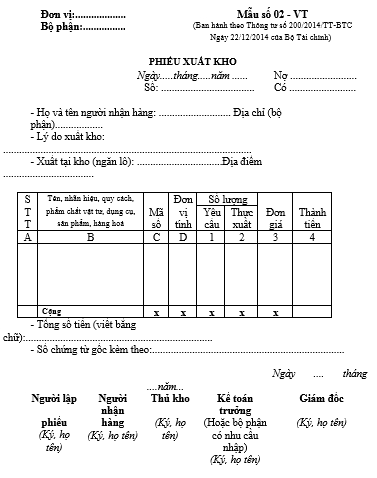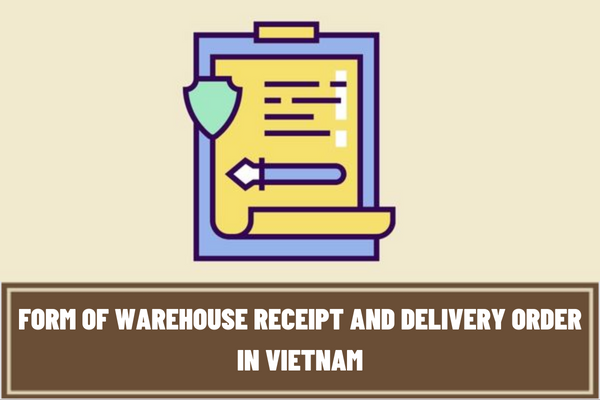What are the regulations on the form of warehouse receipt and delivery order for enterprises in Vietnam? How to write warehouse receipts and delivery orders?
- What are the regulations on the latest form of warehouse receipt for enterprises in Vietnam?
- How to write the latest warehouse receipt for enterprises in Vietnam?
- What are the regulations on the form of delivery order for enterprises in Vietnam?
- How to write the latest delivery order for enterprises in Vietnam?
What are the regulations on the latest form of warehouse receipt for enterprises in Vietnam?
Currently, the latest form of warehouse receipt in Vietnam for enterprises is specified in Form No. 01- VT enclosed with Circular 200/2014/TT-BTC of Vietnam as follows:

Download the latest form of warehouse receipt in Vietnam for enterprises: Click here.

What are the regulations on the form of warehouse receipt and delivery order for enterprises in Vietnam? How to write warehouse receipts and delivery orders?
How to write the latest warehouse receipt for enterprises in Vietnam?
- How to write warehouse receipts according to Circular 200/2014/TT-BTC of Vietnam as follows:
+ The upper left corner of the warehouse receipt must clearly state the name of the unit (or stamp the unit), the warehouse department. The warehouse receipt is applied in cases where materials, gears, tools, products and goods are purchased from outside, produced by themselves, outsourced for processing, received capital contribution, or discovered in inventory.
+ When making a warehouse receipt, it is required to clearly specify the number of the entry slip and the date, month and year of making the bill, the full name of the person delivering the supplies, gears, tools, products, goods, the invoice number or the warehouse order, and the name of the warehouse, the import warehouse location.
+ Columns A, B, C, D: Write the ordinal number, name, brand, specification, quality, code and unit of calculation of supplies, tools, tools, products and goods.
+ Column 1: Enter the quantity according to the voucher (invoice or import order).
+ Column 2: The storekeeper writes the actual quantity entered into the warehouse.
+ Column 3, 4: Because the accountant writes the unit price (accounting price or invoice price,... depending on the regulations of each unit) and calculates the amount of each material, tool, product, and actual imported goods.
+ The plus line: Write the total amount of all kinds of supplies, tools, tools, products, and goods imported with the same warehouse receipt.
+ Amount line written in words: Write the total amount on the warehouse receipt in words.
The warehouse receipt is made in 2 copies by the purchasing department or by the production department (for supplies and goods purchased from outside) or 3 copies (for self-manufactured materials) (ordering carbon paper once to be written), and the person making the form signs (specify full name), the delivery person brings the slip to the warehouse to import supplies, tools, products and goods.
After entering the warehouse, the warehouse keeper writes the date, month and year of entering the warehouse and signs the slip with the delivery person, the storekeeper keeps copy 2 to write on the warehouse card and then transfers it to the accounting department to write the accounting books and copy 1 is kept at the place of making the ballot, copy 3 (if any) is kept by the delivery person.
What are the regulations on the form of delivery order for enterprises in Vietnam?
Currently, the latest form of delivery order in Vietnam for enterprises is specified in Form No. 02-VT enclosed with Circular 200/2014/TT-BTC of Vietnam as follows:

Download the latest form of delivery order in Vietnam for enterprises: Click here
How to write the latest delivery order for enterprises in Vietnam?
- How to write the delivery order in Vietnam as follows:
+ The left corner of the ex-warehousing note must clearly state the name of the unit (or stamp the unit) and the ex-warehousing department. The warehouse release note is made for one or more supplies, gears, tools, products and goods in the same warehouse for a single cost-accounting object or for the same use purpose.
+ When making an ex-warehousing bill, it must clearly state: Full name of consignee, name, unit (department): number and date, month and year of making the bill; reasons for stock-out and warehouse-out of supplies, tools, tools, products and goods.
Columns A, B, C, D: Enter ordinal numbers, names, brands, specifications, qualities, codes and units of calculation of supplies, tools, tools, products and goods.
Column 1: Enter the quantity of supplies, tools, tools, products and goods as required by the user (department).
Column 2: The warehouse keeper writes the actual quantity released from the warehouse (the actual quantity can only be equal to or less than the required quantity).
Column 3, 4: The accountant writes the unit price (depending on the accounting regulations of the enterprise) and calculates the cash value of each type of supplies, tools, tools, products and goods (column 4 = column 2). x column 3).
Plus line: Enter the total amount of the actual amount of materials, tools, tools, products and goods actually shipped.
Line "Total amount in words": Enter the total amount written in words on the delivery order.
The warehouse release note is made by the departments that apply for receipt or by the management department, the warehouse department (depending on the management organization and regulations of each enterprise) in 3 copies (putting a carbon paper written once). After completing the form, the person making the form and the chief accountant shall sign it and transfer it to the director or an authorized person for approval (specify full name) and hand it over to the recipient to take the slip to the warehouse to receive the goods.
After releasing the warehouse, the warehouse keeper shall write in column 2 the actual quantity of each item, write the date, month and year of delivery and sign the release note together with the consignee (specify full name).
+ Copy 1: Save in the voting section.
+ Copy 2: The storekeeper keeps for writing in the inventory card and then transfers it to the accountant for the accountant to write in columns 3, 4 and write in the accounting books.
+ Copy 3: The recipient of supplies, tools, tools, products and goods kept for monitoring in the use department.
LawNet
